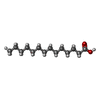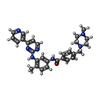[English] 日本語
 Yorodumi
Yorodumi- PDB-1opj: Structural basis for the auto-inhibition of c-Abl tyrosine kinase -
+ Open data
Open data
- Basic information
Basic information
| Entry | Database: PDB / ID: 1opj | ||||||
|---|---|---|---|---|---|---|---|
| Title | Structural basis for the auto-inhibition of c-Abl tyrosine kinase | ||||||
 Components Components | Proto-oncogene tyrosine-protein kinase ABL1 | ||||||
 Keywords Keywords | TRANSFERASE | ||||||
| Function / homology |  Function and homology information Function and homology informationRole of ABL in ROBO-SLIT signaling / HDR through Single Strand Annealing (SSA) / RHO GTPases Activate WASPs and WAVEs / Cyclin D associated events in G1 / MLL4 and MLL3 complexes regulate expression of PPARG target genes in adipogenesis and hepatic steatosis / Recruitment and ATM-mediated phosphorylation of repair and signaling proteins at DNA double strand breaks / Turbulent (oscillatory, disturbed) flow shear stress activates signaling by PIEZO1 and integrins in endothelial cells / protein localization to cytoplasmic microtubule plus-end / DNA conformation change / DN4 thymocyte differentiation ...Role of ABL in ROBO-SLIT signaling / HDR through Single Strand Annealing (SSA) / RHO GTPases Activate WASPs and WAVEs / Cyclin D associated events in G1 / MLL4 and MLL3 complexes regulate expression of PPARG target genes in adipogenesis and hepatic steatosis / Recruitment and ATM-mediated phosphorylation of repair and signaling proteins at DNA double strand breaks / Turbulent (oscillatory, disturbed) flow shear stress activates signaling by PIEZO1 and integrins in endothelial cells / protein localization to cytoplasmic microtubule plus-end / DNA conformation change / DN4 thymocyte differentiation / response to epinephrine / phospholipase C-inhibiting G protein-coupled receptor signaling pathway / podocyte apoptotic process / RUNX1 regulates transcription of genes involved in differentiation of HSCs / delta-catenin binding / transitional one stage B cell differentiation / regulation of postsynaptic specialization assembly / regulation of modification of synaptic structure / cerebellum morphogenesis / regulation of cellular senescence / neuroepithelial cell differentiation / B cell proliferation involved in immune response / Regulation of actin dynamics for phagocytic cup formation / positive regulation of extracellular matrix organization / positive regulation of Wnt signaling pathway, planar cell polarity pathway / microspike assembly / B-1 B cell homeostasis / neuropilin signaling pathway / neuropilin binding / regulation of extracellular matrix organization / Myogenesis / bubble DNA binding / positive regulation of establishment of T cell polarity / activated T cell proliferation / positive regulation of blood vessel branching / proline-rich region binding / negative regulation of mitotic cell cycle / regulation of Cdc42 protein signal transduction / circulatory system development / mitogen-activated protein kinase binding / syntaxin binding / positive regulation of dendrite development / positive regulation of cell migration involved in sprouting angiogenesis / alpha-beta T cell differentiation / regulation of axon extension / regulation of T cell differentiation / positive regulation of peptidyl-tyrosine phosphorylation / negative regulation of cell-cell adhesion / neuromuscular process controlling balance / positive regulation of osteoblast proliferation / platelet-derived growth factor receptor-beta signaling pathway / positive regulation of vasoconstriction / platelet-derived growth factor receptor signaling pathway / cell leading edge / Bergmann glial cell differentiation / regulation of microtubule polymerization / B cell proliferation / negative regulation of long-term synaptic potentiation / myoblast proliferation / negative regulation of cellular senescence / associative learning / signal transduction in response to DNA damage / positive regulation of focal adhesion assembly / negative regulation of BMP signaling pathway / canonical NF-kappaB signal transduction / cardiac muscle cell proliferation / ephrin receptor signaling pathway / phagocytosis / BMP signaling pathway / cellular response to transforming growth factor beta stimulus / negative regulation of endothelial cell apoptotic process / endothelial cell migration / positive regulation of T cell migration / negative regulation of double-strand break repair via homologous recombination / spleen development / ephrin receptor binding / four-way junction DNA binding / positive regulation of stress fiber assembly / ruffle / ERK1 and ERK2 cascade / phosphotyrosine residue binding / actin filament polymerization / positive regulation of substrate adhesion-dependent cell spreading / substrate adhesion-dependent cell spreading / positive regulation of interleukin-2 production / positive regulation of mitotic cell cycle / SH2 domain binding / peptidyl-tyrosine phosphorylation / protein kinase C binding / thymus development / response to endoplasmic reticulum stress / positive regulation of release of sequestered calcium ion into cytosol / integrin-mediated signaling pathway / post-embryonic development / B cell receptor signaling pathway / regulation of actin cytoskeleton organization / non-membrane spanning protein tyrosine kinase activity / non-specific protein-tyrosine kinase / neural tube closure / establishment of localization in cell Similarity search - Function | ||||||
| Biological species |  | ||||||
| Method |  X-RAY DIFFRACTION / X-RAY DIFFRACTION /  SYNCHROTRON / SYNCHROTRON /  MOLECULAR REPLACEMENT / Resolution: 1.75 Å MOLECULAR REPLACEMENT / Resolution: 1.75 Å | ||||||
 Authors Authors | Nagar, B. / Hantschel, O. / Young, M.A. / Scheffzek, K. / Veach, D. / Bornmann, W. / Clarkson, B. / Superti-Furga, G. / Kuriyan, J. | ||||||
 Citation Citation |  Journal: Cell(Cambridge,Mass.) / Year: 2003 Journal: Cell(Cambridge,Mass.) / Year: 2003Title: Structural basis for the autoinhibition of c-Abl tyrosine kinase Authors: Nagar, B. / Hantschel, O. / Young, M.A. / Scheffzek, K. / Veach, D. / Bornmann, W. / Clarkson, B. / Superti-Furga, G. / Kuriyan, J. #1:  Journal: Cell(Cambridge,Mass.) / Year: 2003 Journal: Cell(Cambridge,Mass.) / Year: 2003Title: A myristoyl/phosphotyrosine switch regulates c-Abl Authors: Hantschel, O. / Nagar, B. / Guettler, S. / Kretzschmar, J. / Dorey, K. / Kuriyan, J. / Superti-Furga, G. | ||||||
| History |
| ||||||
| Remark 999 | SEQUENCE Myristoylated peptide (MYR)GQQPGKVLGDQRRPSL was crystallized in complex with the kinase ...SEQUENCE Myristoylated peptide (MYR)GQQPGKVLGDQRRPSL was crystallized in complex with the kinase domain. This sequence corresponds to the N-terminal 16 residues of mouse C-ABL(isoform IV). However, only the myristoyl portion of the peptide has density and all residues beyond the myristoyl group are disordered, therefore they are not modeled. An O atom has been intentionally omitted from MYR since the O atom is not chemically present in a myristoyl group that is attached to peptide. Residues numbering for the chains A and B corresponds to the sequence database numbering of the isoform IV of the protein. |
- Structure visualization
Structure visualization
| Structure viewer | Molecule:  Molmil Molmil Jmol/JSmol Jmol/JSmol |
|---|
- Downloads & links
Downloads & links
- Download
Download
| PDBx/mmCIF format |  1opj.cif.gz 1opj.cif.gz | 134.9 KB | Display |  PDBx/mmCIF format PDBx/mmCIF format |
|---|---|---|---|---|
| PDB format |  pdb1opj.ent.gz pdb1opj.ent.gz | 105.3 KB | Display |  PDB format PDB format |
| PDBx/mmJSON format |  1opj.json.gz 1opj.json.gz | Tree view |  PDBx/mmJSON format PDBx/mmJSON format | |
| Others |  Other downloads Other downloads |
-Validation report
| Summary document |  1opj_validation.pdf.gz 1opj_validation.pdf.gz | 863.9 KB | Display |  wwPDB validaton report wwPDB validaton report |
|---|---|---|---|---|
| Full document |  1opj_full_validation.pdf.gz 1opj_full_validation.pdf.gz | 885.8 KB | Display | |
| Data in XML |  1opj_validation.xml.gz 1opj_validation.xml.gz | 27.6 KB | Display | |
| Data in CIF |  1opj_validation.cif.gz 1opj_validation.cif.gz | 37.8 KB | Display | |
| Arichive directory |  https://data.pdbj.org/pub/pdb/validation_reports/op/1opj https://data.pdbj.org/pub/pdb/validation_reports/op/1opj ftp://data.pdbj.org/pub/pdb/validation_reports/op/1opj ftp://data.pdbj.org/pub/pdb/validation_reports/op/1opj | HTTPS FTP |
-Related structure data
| Related structure data | 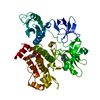 1opkC  1oplC  1iepS C: citing same article ( S: Starting model for refinement |
|---|---|
| Similar structure data |
- Links
Links
- Assembly
Assembly
| Deposited unit | 
| ||||||||
|---|---|---|---|---|---|---|---|---|---|
| 1 | 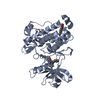
| ||||||||
| 2 | 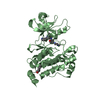
| ||||||||
| Unit cell |
|
- Components
Components
| #1: Protein | Mass: 33743.523 Da / Num. of mol.: 2 / Fragment: KINASE DOMAIN Source method: isolated from a genetically manipulated source Source: (gene. exp.)   #2: Chemical | #3: Chemical | #4: Chemical | #5: Water | ChemComp-HOH / | |
|---|
-Experimental details
-Experiment
| Experiment | Method:  X-RAY DIFFRACTION / Number of used crystals: 1 X-RAY DIFFRACTION / Number of used crystals: 1 |
|---|
- Sample preparation
Sample preparation
| Crystal | Density Matthews: 2.22 Å3/Da / Density % sol: 44.06 % | ||||||||||||||||||||||||||||||||||||||||||||||||||||||||
|---|---|---|---|---|---|---|---|---|---|---|---|---|---|---|---|---|---|---|---|---|---|---|---|---|---|---|---|---|---|---|---|---|---|---|---|---|---|---|---|---|---|---|---|---|---|---|---|---|---|---|---|---|---|---|---|---|---|
| Crystal grow | Temperature: 277 K / Method: vapor diffusion, hanging drop / pH: 5.6 Details: 22% PEG 4000, 100 mM MES pH 5.6, 200 mM magnesium chloride, VAPOR DIFFUSION, HANGING DROP, temperature 277K | ||||||||||||||||||||||||||||||||||||||||||||||||||||||||
| Crystal grow | *PLUS Temperature: 4 ℃ / pH: 8 | ||||||||||||||||||||||||||||||||||||||||||||||||||||||||
| Components of the solutions | *PLUS
|
-Data collection
| Diffraction | Mean temperature: 100 K |
|---|---|
| Diffraction source | Source:  SYNCHROTRON / Site: SYNCHROTRON / Site:  ESRF ESRF  / Beamline: ID14-1 / Wavelength: 0.934 Å / Beamline: ID14-1 / Wavelength: 0.934 Å |
| Detector | Type: ADSC QUANTUM 4 / Detector: CCD / Date: Jul 10, 2002 / Details: Sagitally focusing Ge(220) and a multilayer |
| Radiation | Monochromator: Diamond (111), Ge(220) / Protocol: SINGLE WAVELENGTH / Monochromatic (M) / Laue (L): M / Scattering type: x-ray |
| Radiation wavelength | Wavelength: 0.934 Å / Relative weight: 1 |
| Reflection | Resolution: 1.7→30 Å / Num. all: 61592 / Num. obs: 61592 / % possible obs: 92.9 % / Observed criterion σ(F): 0 / Observed criterion σ(I): -3 / Redundancy: 4.4 % / Biso Wilson estimate: 21.6 Å2 / Rsym value: 0.09 / Net I/σ(I): 9.41 |
| Reflection shell | Resolution: 1.7→1.8 Å / Redundancy: 3.6 % / Mean I/σ(I) obs: 2.84 / Num. unique all: 7906 / Rsym value: 0.509 / % possible all: 75.8 |
| Reflection | *PLUS Lowest resolution: 30 Å / Num. measured all: 268488 / Rmerge(I) obs: 0.09 |
| Reflection shell | *PLUS Highest resolution: 1.7 Å / Lowest resolution: 1.8 Å / % possible obs: 75.8 % / Rmerge(I) obs: 0.509 / Mean I/σ(I) obs: 2.8 |
- Processing
Processing
| Software |
| ||||||||||||||||||||||||||||||||||||
|---|---|---|---|---|---|---|---|---|---|---|---|---|---|---|---|---|---|---|---|---|---|---|---|---|---|---|---|---|---|---|---|---|---|---|---|---|---|
| Refinement | Method to determine structure:  MOLECULAR REPLACEMENT MOLECULAR REPLACEMENTStarting model: PDB ENTRY 1IEP Resolution: 1.75→29.41 Å / Rfactor Rfree error: 0.005 / Isotropic thermal model: RESTRAINED / Cross valid method: THROUGHOUT / σ(F): 0 / Stereochemistry target values: Engh & Huber
| ||||||||||||||||||||||||||||||||||||
| Solvent computation | Solvent model: FLAT MODEL / Bsol: 31.7556 Å2 / ksol: 0.363517 e/Å3 | ||||||||||||||||||||||||||||||||||||
| Displacement parameters | Biso mean: 30 Å2
| ||||||||||||||||||||||||||||||||||||
| Refine analyze |
| ||||||||||||||||||||||||||||||||||||
| Refinement step | Cycle: LAST / Resolution: 1.75→29.41 Å
| ||||||||||||||||||||||||||||||||||||
| Refine LS restraints |
| ||||||||||||||||||||||||||||||||||||
| LS refinement shell | Resolution: 1.75→1.86 Å / Rfactor Rfree error: 0.015 / Total num. of bins used: 6
| ||||||||||||||||||||||||||||||||||||
| Xplor file |
| ||||||||||||||||||||||||||||||||||||
| Refinement | *PLUS Highest resolution: 1.7 Å / Lowest resolution: 30 Å / Rfactor Rwork: 0.21 | ||||||||||||||||||||||||||||||||||||
| Solvent computation | *PLUS | ||||||||||||||||||||||||||||||||||||
| Displacement parameters | *PLUS | ||||||||||||||||||||||||||||||||||||
| Refine LS restraints | *PLUS
| ||||||||||||||||||||||||||||||||||||
| LS refinement shell | *PLUS Highest resolution: 1.7 Å / Lowest resolution: 1.8 Å |
 Movie
Movie Controller
Controller


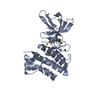

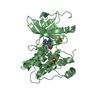
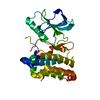

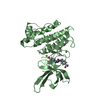

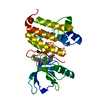
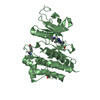
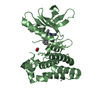
 PDBj
PDBj











